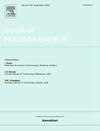Neutron total and capture cross-section measurement and resolved resonance analysis of Er
IF 2.3
3区 工程技术
Q1 NUCLEAR SCIENCE & TECHNOLOGY
引用次数: 0
Abstract
The neutron total and capture cross sections of Er were measured at the Accurate Neutron-Nucleus Reaction Measurement Instrument beamline in the Materials and Life Science Experimental Facility of the Japan Proton Accelerator Research Complex. For the neutron total cross-section measurements, Li-glass detectors were employed to derive the neutron transmission ratio of three Er transmission samples with thicknesses of 1 mm, 0.175 mm and 0.05 mm. The neutron capture cross-section was determined from measurements of 0.025-mm-thick Er samples with NaI(Tl) and Ge spectrometers in separate experiments, since they offer complementary capabilities. Moreover, the capture cross-section of 167Er was derived below 1 eV, since it accounted for over 95% of the capture events in Er. For the neutron total cross-section, at the thermal energy, the present results align with the JENDL-5, ENDF/B-VIII.0 and JEFF-3.3 evaluated nuclear data, the past experimental results of Danon et al. and the recommended values of Mughabghab. For the capture cross-section, similar consistencies were found for Er and 167Er, with the present results agreeing within uncertainties with the JENDL-5, ENDF/B-VIII.0 and JEFF-3.3 recommended values, the work of Danon et al. and the evaluation of Mughabghab. In addition, the resolved resonance region up to 65 eV was analyzed using the REFIT code. The resonance parameters of 20 167Er resonances, together with one resonance for each 164Er and 166Er were determined in a least-square fit using a combination of both capture data and the transmission data from the thicker 1 mm and 0.175 mm samples. The fitting results were found to be highly consistent in-between the four measured data sets, providing convincing experimental data to improve the current knowledge of the resonance region for the Er isotopes in nuclear data libraries, which diverged from the present experimental results in terms of both resonance energy and resonance kernels for most of the resonances above 20 eV.

铒的中子总俘获截面测量及分辨共振分析
在日本质子加速器研究中心材料与生命科学实验设施的精确中子-核反应测量仪光束线上测量了水的中子总量和俘获截面。在中子总截面测量方面,利用Li-glass探测器计算了厚度分别为1 mm、0.175 mm和0.05 mm的三种水透射样品的中子透射比。中子捕获截面是用NaI(Tl)和Ge光谱仪在单独的实验中测量0.025 mm厚的水样品来确定的,因为它们具有互补的能力。此外,167Er的捕获截面在1 eV以下,因为它占了水中捕获事件的95%以上。对于中子总截面,在热能处,本文的结果与JENDL-5, ENDF/B-VIII一致。0和JEFF-3.3分别评价了核数据、Danon等人过去的实验结果和Mughabghab的推荐值。对于捕获截面,在natEr和167Er中发现了类似的一致性,目前的结果与JENDL-5, ENDF/B-VIII在不确定度内一致。0和JEFF-3.3推荐值,Danon等人的工作和Mughabghab的评价。此外,利用REFIT代码分析了高达65 eV的解析共振区域。利用较厚的1 mm和0.175 mm样品的捕获数据和透射数据,通过最小二乘拟合确定了20个167Er共振的共振参数,以及每个164Er和166Er的一个共振。四组实测数据之间的拟合结果高度一致,为改进目前对核数据库中Er同位素共振区域的认识提供了有说服力的实验数据,该区域在20 eV以上的大多数共振能量和共振核方面都与目前的实验结果存在分歧。
本文章由计算机程序翻译,如有差异,请以英文原文为准。
求助全文
约1分钟内获得全文
求助全文
来源期刊

Annals of Nuclear Energy
工程技术-核科学技术
CiteScore
4.30
自引率
21.10%
发文量
632
审稿时长
7.3 months
期刊介绍:
Annals of Nuclear Energy provides an international medium for the communication of original research, ideas and developments in all areas of the field of nuclear energy science and technology. Its scope embraces nuclear fuel reserves, fuel cycles and cost, materials, processing, system and component technology (fission only), design and optimization, direct conversion of nuclear energy sources, environmental control, reactor physics, heat transfer and fluid dynamics, structural analysis, fuel management, future developments, nuclear fuel and safety, nuclear aerosol, neutron physics, computer technology (both software and hardware), risk assessment, radioactive waste disposal and reactor thermal hydraulics. Papers submitted to Annals need to demonstrate a clear link to nuclear power generation/nuclear engineering. Papers which deal with pure nuclear physics, pure health physics, imaging, or attenuation and shielding properties of concretes and various geological materials are not within the scope of the journal. Also, papers that deal with policy or economics are not within the scope of the journal.
 求助内容:
求助内容: 应助结果提醒方式:
应助结果提醒方式:


